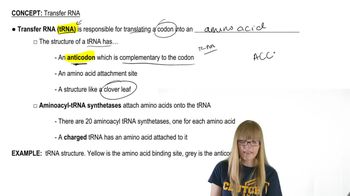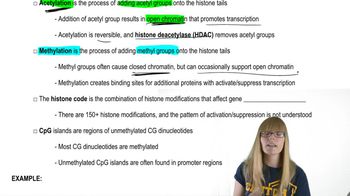Table of contents
- 1. Introduction to Genetics51m
- 2. Mendel's Laws of Inheritance3h 37m
- 3. Extensions to Mendelian Inheritance2h 41m
- 4. Genetic Mapping and Linkage2h 28m
- 5. Genetics of Bacteria and Viruses1h 21m
- 6. Chromosomal Variation1h 48m
- 7. DNA and Chromosome Structure56m
- 8. DNA Replication1h 10m
- 9. Mitosis and Meiosis1h 34m
- 10. Transcription1h 0m
- 11. Translation58m
- 12. Gene Regulation in Prokaryotes1h 19m
- 13. Gene Regulation in Eukaryotes44m
- 14. Genetic Control of Development44m
- 15. Genomes and Genomics1h 50m
- 16. Transposable Elements47m
- 17. Mutation, Repair, and Recombination1h 6m
- 18. Molecular Genetic Tools19m
- 19. Cancer Genetics29m
- 20. Quantitative Genetics1h 26m
- 21. Population Genetics50m
- 22. Evolutionary Genetics29m
13. Gene Regulation in Eukaryotes
Epigenetics, Chromatin Modifications, and Regulation
Problem 23c
Textbook Question
Amino acids are classified as positively charged, negatively charged, or electrically neutral.
How does this property of lysine allow it to interact with DNA?
 Verified step by step guidance
Verified step by step guidance1
<Lysine is an amino acid with a side chain that contains an amino group, which is positively charged at physiological pH.>
<DNA is composed of nucleotides, each containing a phosphate group that is negatively charged.>
<The positive charge on lysine's side chain allows it to form electrostatic interactions with the negatively charged phosphate groups of DNA.>
<These interactions help stabilize the structure of DNA and can influence the binding of proteins to DNA.>
<This property of lysine is crucial in the context of histone proteins, which are rich in lysine and play a key role in DNA packaging within the cell nucleus.>
Recommended similar problem, with video answer:
 Verified Solution
Verified SolutionThis video solution was recommended by our tutors as helpful for the problem above
Video duration:
1mPlay a video:
Was this helpful?
Key Concepts
Here are the essential concepts you must grasp in order to answer the question correctly.
Amino Acid Classification
Amino acids are organic compounds that serve as the building blocks of proteins. They can be classified based on their side chains into three categories: positively charged (basic), negatively charged (acidic), and electrically neutral. This classification affects their interactions with other molecules, including nucleic acids like DNA.
Recommended video:
Lysine's Positive Charge
Lysine is an amino acid that carries a positive charge at physiological pH due to its amino group. This positive charge allows lysine to form ionic bonds with negatively charged molecules, such as the phosphate backbone of DNA. Such interactions are crucial for stabilizing protein-DNA complexes and facilitating processes like transcription and replication.
Recommended video:
Guided course

Positional Cloning
DNA Structure and Charge
DNA is a negatively charged molecule primarily due to its phosphate groups. The negative charge of DNA plays a significant role in its interactions with positively charged amino acids like lysine. Understanding this charge interaction is essential for grasping how proteins bind to DNA and regulate gene expression.
Recommended video:
Guided course

DNA Structure







